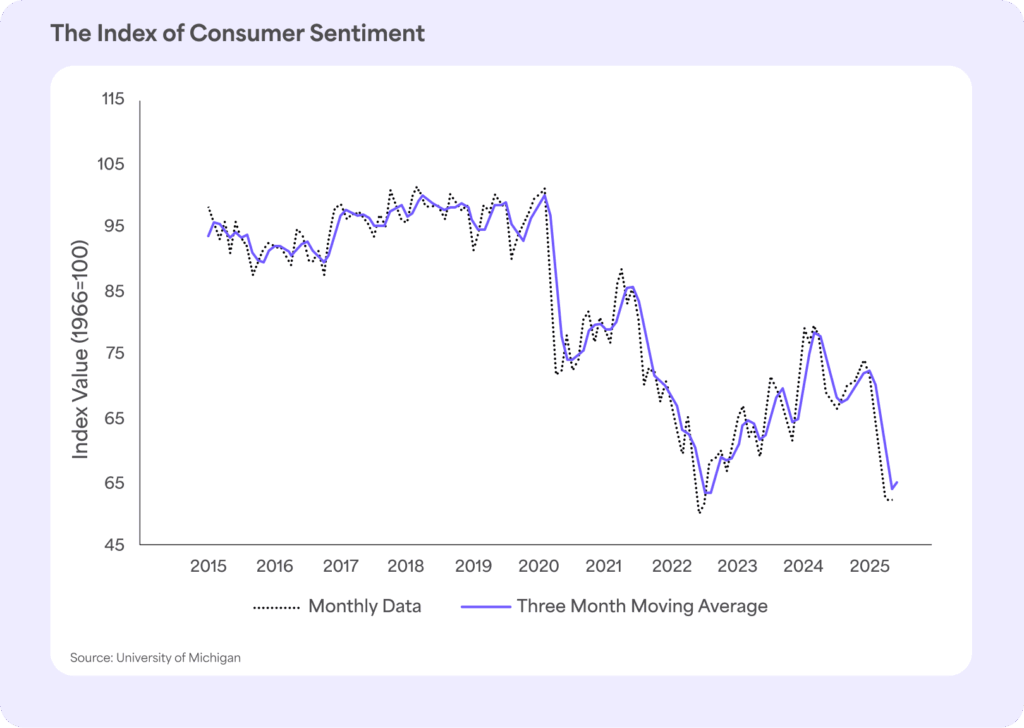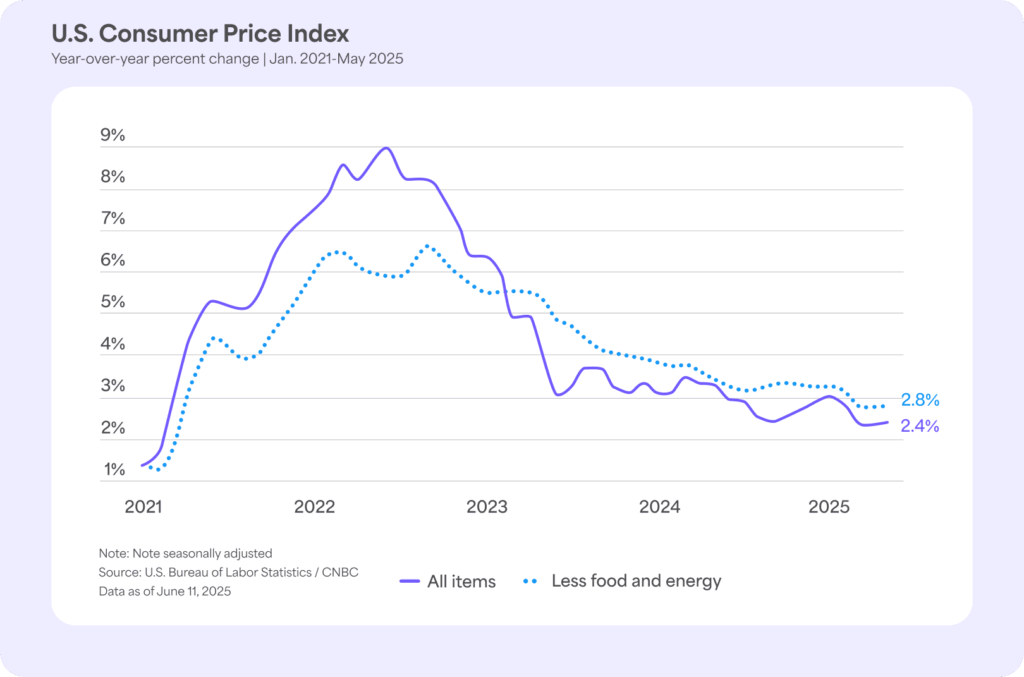3 Surprising Economic Trends Faith Leaders Should Watch (and What They Mean for 2025 Church Giving)

If 2025 has felt like a rollercoaster, you’re not alone. From rising tariffs to renewed inflation concerns and political shifts, this year has kept both households and places of worship on their toes.
Many pastors and faith leaders have been asking the same question:
Will people still be able — and willing — to give?
The good news? Amid the uncertainty, several key economic indicators are moving in a positive direction. And while these shifts might not make news headlines, they set the stage for encouraging 2025 church giving trends that faith leaders should watch closely.
At the start of the year, we projected that 2025 church giving would hold steady — or even exceed — 2024 levels, with a potential increase of 2–3%. That projection was based on early signs like stabilizing inflation.
Now that we’re halfway through the year, updated economic data suggests we’re still on track — and pastors and faith leaders have real opportunities to build on this momentum.
As Givelify’s Chief Economist, Abiodun Mafolasire, notes, “While the economic landscape remains complex, the positive movement of some economic indicators creates a unique window for faith communities to engage generosity in new and meaningful ways this year.”
Here are three economic trends worth watching — and how they might shape your faith and church giving in 2025.
Trend #1: Consumer confidence is on the rise
The good news: Consumer sentiment jumped 16% in June 2025 compared to May, according to the University of Michigan’s Survey of Consumers. This marks the first increase in six months and a strong signal that Americans are feeling more confident about their financial future.
Why this matters for faith and church giving: When people feel financially secure, they’re more likely to be generous. That doesn’t necessarily mean large gifts — but it does mean that people may feel more freedom to support causes they care about, including their local church or place of worship.
This rise in consumer confidence is one of the leading factors shaping current 2025 church giving trends, signaling potential growth in generosity.

What to watch for:
- Keep an eye on monthly consumer confidence reports. Higher numbers typically signal a greater willingness to give.
- Check the University of Michigan’s Survey of Consumers website for bi-weekly updates that can provide insight into public sentiment.
How to respond:
- Share stories of good. Remind people of the impact their giving makes on their congregation and community.
- Tie generosity to momentum. Use this uptick in confidence to frame giving as part of a larger, hopeful story about the impact your church is making in the community.
Trend #2: Wages are increasing
The good news: U.S. wages grew more than expected in May 2025, according to the U.S. Bureau of Labor Statistics. Average hourly earnings rose by 0.4% in just one month and are up 3.9% compared to a year ago.
Why this matters for faith and church giving: When wages rise, so does disposable income — the money left over after essential expenses like housing, food, and transportation. This creates more room in people’s budgets for giving, especially if inflation remains stable (more on that below).
While unemployment did tick up slightly in May, job growth remained relatively steady overall — a good sign for households’ long-term financial health.
What to watch for:
- Continued increases in average hourly earnings and steady or falling unemployment suggest that many households have more disposable income — a positive signal for potential increases in giving.
- Stay updated with monthly reports from the U.S. Bureau of Labor Statistics. The next report for June will be released on Thursday, July 3, 2025.
How to respond:
- Encourage new givers. Even small increases in income can be a spiritual turning point for someone just beginning their giving journey.
- Normalize starting small. A growing paycheck doesn’t automatically lead to large donations — but it can create the space for your donors to build consistent giving habits.
Trend #3: Inflation is stabilizing
The good news: In May 2025, the Consumer Price Index — a key measure of inflation — rose just 0.1% from April. That’s well within the normal month-to-month range of 0.2%. Year-over-year, inflation edged up slightly to 2.4% from 2.3% in April but remains close to the Federal Reserve’s target rate of 2%.

Why this matters for faith and church giving: When prices are stable, people feel more in control of their finances. They’re less likely to worry about affording essentials and more likely to consider giving part of their income away. Stable inflation also boosts confidence in the overall economy — which also supports generosity.
What to watch for:
- Rather than focusing on year-over-year inflation spikes, pay attention to monthly trends and category-specific changes (like food, energy, or housing) that affect your community most.
- Track monthly inflation updates from the U.S. Bureau of Labor Statistics. The next Consumer Price Index report for June will be released on Tuesday, July 15, 2025.
How to respond:
- Acknowledge stability. Help your congregation feel confident about giving by recognizing the return of financial steadiness and encouraging small, consistent acts of generosity.
- Refresh your message. Revisit how you talk about giving — focus on gratitude, trust, and the impact of steady support during more predictable times.
What pastors and faith leaders can do now to strengthen 2025 church giving
These economic trends open up real possibilities — but the key is acting on them. Here are three ways you can lean into this moment and encourage generosity within your church or place of worship:
1. Cast a bold vision
With encouraging economic signals on the horizon, this is the perfect moment to pause and reflect on your organization’s vision. Before inviting others to support it, make sure it’s clear and meaningful to you.
A strong, purpose-driven vision is what motivates consistent support — especially during uncertain times.
What to do:
- Ask yourself: What impact do we want to make in the second half of the year? What priorities or goals feel most urgent or inspiring right now?
- Clarify your “why”: Look back on the year so far. What moments or milestones stand out? What lessons can you carry forward?
- Use your insights to guide your communication: When your vision is grounded in clear purpose, it becomes easier to communicate authentically — whether in a giving appeal, a message to your community, or a budget conversation.
2. Revisit how you teach consistent giving
Economic uncertainty often makes people hesitant to give. But many are still willing to give — especially when they understand that consistency, not dollar amount, is what makes the biggest difference over time.
A steady rhythm of giving helps your organization plan, grow, and serve — even when the economy feels unpredictable.
What to do:
- Ask yourself: When was the last time you talked about the importance of consistent giving? How often do you teach or model this in your messages, conversations, or communications?
- Reframe the ask: Emphasize that consistent giving isn’t just a financial habit — it’s a meaningful way for congregants to live out the teaching of their faith in their everyday life.
- Make it easy to practice: Offer simple, repeatable ways for people to give — like a mobile giving app like Givelify. Share stories that highlight how even small, regular gifts have made a lasting impact.
3. Stay informed
As a pastor or faith leader, you don’t need a degree in economics — but a working understanding of key economic trends can help you lead with confidence. Encouraging generosity doesn’t mean ignoring hard realities; it means responding with grounded optimism and wisdom.
What to do:
- Ask yourself: Where am I getting my information? Do I feel equipped to understand and talk about how the economy might affect our community?
- Choose credible sources: Look to sources like the U.S. Bureau of Labor Statistics and the University of Michigan to stay up-to-date on the latest economic trends.
- Share what you’re learning: Communicate with your leadership team or board so you can respond proactively — not reactively — to changes in faith and church giving.
Why these economic trends matter for 2025 church giving
While uncertainty still lingers in the background, the economic story of 2025 is far more hopeful than fearful. With rising consumer confidence, growing wages, and stabilizing inflation, faith communities are entering a season of opportunity — not scarcity.
These trends don’t guarantee generosity, but they create space for it to grow. As a pastor or faith leader, your voice matters in how people respond. Speak boldly about your vision, teach consistency, and stay grounded in both faith and facts.
Because generosity doesn’t just fund ministry — it nurtures spiritual growth. And right now, you have a meaningful opportunity to cultivate both.



